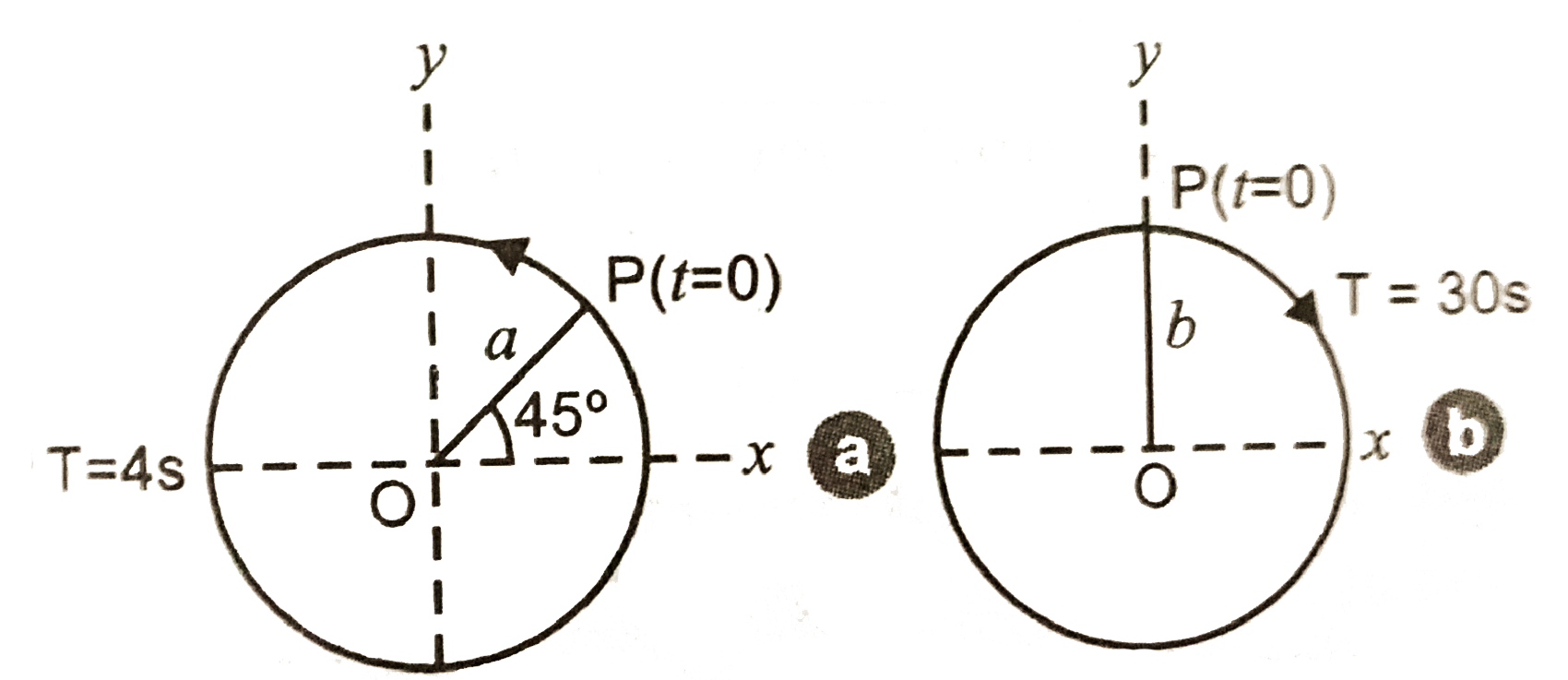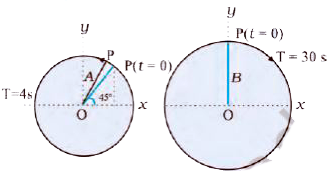The figure given below depicts two circular motions. The radius of the circle, the period of revolution, the initial position and the sense of revolution are indicated in the figures. Obtain the simple harmonic motions of the x-projection of the radius vector of the rotating particle P in each case.
 Solution in Tamil
Solution in Tamil
(a) At t = 0, OP makes an angle of 45∘=π/4 rad with the (positive direction of ) x-axis. After time t, it covers an angle 2πTt in the anticlockwise sense, and makes an angle of 2πTt+π4 with the x-axis.
The projection of OP on the x-axis at time t is given by,
x(t)=Acos(2πTt+π4)
For T=4s.
x(t)=Acos(2π4t+π4)
which is a SHM of amplitude A, period 4 s,
and an initial phase*=π4.
(b) In this case at t = 0, OP makes an angle of 90∘=π2 with the x-axis. After a time t, it covers an angle of 2πTt in the clockwise sense and makes an angle of (π2−2πTt) with the x-axis. The projection of OP on the x-axis at time t is given by
x(t)=Bcos(π2−2πTt)
=Bsin(2πTt)
For T = 30 s,
x(t)=Bsin(π15t)
Writing this as x (t ) = B cos(π15t−π2), and comparing with Eq. (14.4). We find that this represents a SHM of amplitude B, period 30 s, and an initial phase of −π2.
Topper's Solved these Questions
- OSCILLATIONSBook:NCERT TAMILChapter:OSCILLATIONSExercise:Exercises
Explore 28 Videos
- OSCILLATIONSBook:NCERT TAMILChapter:OSCILLATIONSExercise:Additional Exercises
Explore 6 Videos
- NATURE OF PHYSICAL WORLD AND MEASUREMENTBook:NCERT TAMILChapter:NATURE OF PHYSICAL WORLD AND MEASUREMENTExercise:EXERCISE (V. Conceptual Questions)
Explore 5 Videos
- PHYSICAL WORLD Book:NCERT TAMILChapter:PHYSICAL WORLD Exercise:EXERCISES
Explore 15 Videos
Similar Questions
Which of the following examples represent periodic motion?
View SolutionAn air chamber of volume V has a neck area of cross section a into which a ball of mass m just fits and can move up and down without any friction (Fig.14.27). Show that when the ball is pressed down a little and released , it executes SHM. Obtain an expression for the time period of oscillations assuming pressure-volume variations of air to be isothermal [see Fig. 14.27].

View SolutionWhy is it convenient to express the distance of stars in terms of light year (or) parsec rather than in km?
View SolutionSome of the most profound statements on the nature of science have come from Albert Einstein, one of the greatest scientist of all time. What do you think did Einstein mean when he said : ''The most incomprehensible thing about the world is that it is comprehensible''?
View Solutiondepict two circulat mothions. The radius of the circle, the period of revolution, the initial position and sense of revolution are indicated in the figures. Obtain the simple harmonic motinosof the x-projection of the radius vector of the rotating particle P in each case.

View Solutionthe circular motion of a particle. The radius of the circle, the period, sense of revolution and the initial position are indicated on the figure. The simple harmonic motion of the x-projection of the radius vector of the rotating particle P is

View SolutionFigure shows the circular motion of a particle. The radius of the circle, the period, same of revolution and the initial position are indicated on the figure. The simple harmonic motion of the x-projection of the radius vector the rotating particle P is
View Solution
Figure depicts two circular motions. The radius of the circle, the period of revolution, the initial position and the sense of revolution are indicated on the figure. Obtain the SHMs of the x-projection of the radius vector of the rotating particle P in each case.
View SolutionFigure shows the circular motion of a particle. The radius of the circle, the period, sense of revolution and the initial position are indicated in the · figure. The simple harmonic motion of the X-projection of the radius vector of the rotating particle Pis
View SolutionFigure shows the circular motion of a particle. The radius of the circle, the period, sense of revolution and the initial positionn are indicated in the figure. The simple harmonic motion off the x-projection of the radius vector of the rotating particle P is
View SolutionFigure below correspond to two circular motions. The radius of the circle, the period of revolution, the initial position, and the sense of revolution (i.e. clockwise or anticlockwise) are indicated on each figure. Obtain the corresponding simple harmonic motions of the x-projection of the radius vector of the revolving particle P in each case.

View SolutionThe figure given below depicts two circular motions. The radius of the circle, the period of revolution, the initial position and the sense of revolution are indicated in the figures. Obtain the simple harmonic motions of the x-projection of the radius vector of the rotating particle P in each case.

View SolutionFigures 14.25 correspond to two circular motions. The radius of the circle, the period of revolution, the initial position, and the sense of revolution (i.e. clockwise or anti-clockwise) are indicated on each figure.

Obtain the corresponding simple harmonic motions of the x-projection of the radius vector of the revolving particle P, in each case.
View SolutionFigures depicts two circular motions. The radius of the circle, the period of revolution, the initial position and the sense of revolution are indicated on the figures. Obtain the simple harmonic motions of the x-projection of the radius vector of the rotating particle P in each case.

View SolutionFigures depicts two circular motions. The radius of the circle, the period of revolution, the initial position and the sense of revolution are indicated on the figures. Obtain the simple harmonic motions of the x-projection of the radius vector of the rotating particle P in each case.

View Solution

